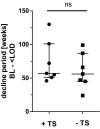HIV-1 persistent viremia is frequently followed by episodes of low-level viremia
- PMID: 28220254
- PMCID: PMC5409919
- DOI: 10.1007/s00430-017-0494-1
HIV-1 persistent viremia is frequently followed by episodes of low-level viremia
Abstract
After the start of antiretroviral therapy (ART), plasma HIV-RNA levels should fall below the limit of detection (LOD) within 24 weeks. Hence, the prolonged decline of HIV-RNA after ART initiation is defined as persistent viremia (PV). In this retrospective study, we analyzed factors associated with PV. Next-generation sequencing of viral RNA/DNA was performed to study viral evolution and the emergence of drug-resistance mutations in HIV-infected patients with PV (n = 20). In addition, HIV-DNA species, immunological parameters, and clinical data of the patients were analyzed. We found that the possible causes for PV were divers, and both virologic and host parameters of this particular cohort were heterogeneous. We identified viruses with therapy-associated DRMs in six patients (30%); two of these were detected as minority variants. Five patients had sub-optimal drug levels (25%) and the baseline plasma viral loads were relatively high. Strikingly, we observed that >40% of the PV patients finally reaching HIV levels below the LOD later on showed up with episodes of low-level viremia (LLV). However, the amount of PBMC derived HIV-DNA species was not correlated with the likelihood of LLV after PV. According to our data, we conclude that drug-resistant viruses, sub-optimal drug level, and high baseline viral loads might be probable reasons for the prolonged RNA decline only in a sub-set of patients. In the absence of emerging DRMs and/or compliance issues, the clinical implications of PV remain unclear; however, PV appears to be a risk factor for episodes of LLV.
Keywords: Antiretroviral therapy; Drug resistance; HIV-1; Low-level viremia (LLV); Persistent viremia (PV); Prolonged decline.
Conflict of interest statement
Funding
This study was in part supported by Janssen-Cilag (TMC114IFD4043).
Statement of human rights
For this type of study, formal consent is not required.
Figures



References
-
- Palmer S, Maldarelli F, Wiegand A, Bernstein B, Hanna GJ, Brun SC, Kempf DJ, Mellors JW, Coffin JM, King MS. Low-level viremia persists for at least 7 years in patients on suppressive antiretroviral therapy. Proc Natl Acad Sci USA. 2008;105(10):3879–3884. doi: 10.1073/pnas.0800050105. - DOI - PMC - PubMed
-
- (EACS) EACS (2016) EACS Guidelines Version 8.1 October 2016. 8.1, October 2016
MeSH terms
Substances
LinkOut - more resources
Full Text Sources
Other Literature Sources
Medical

